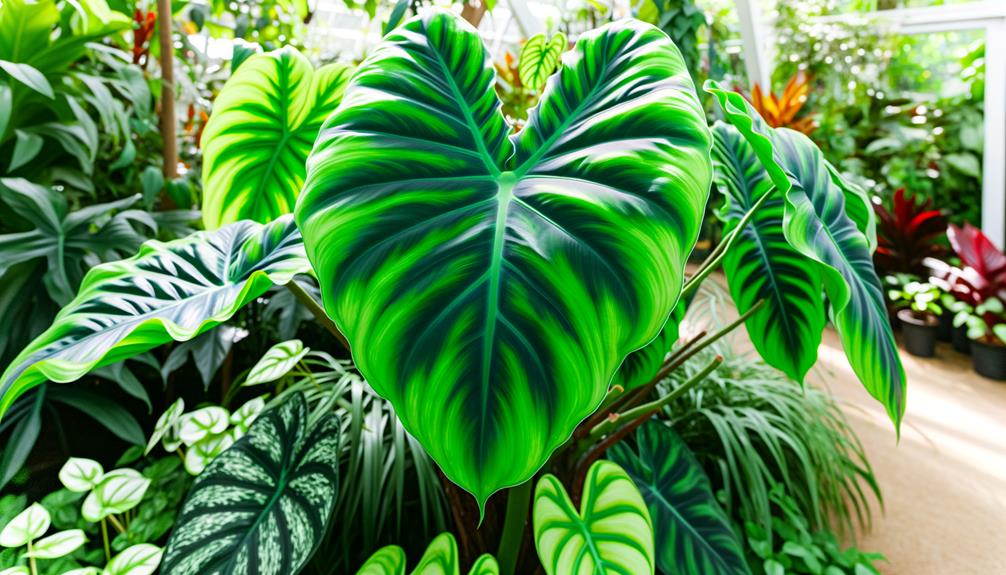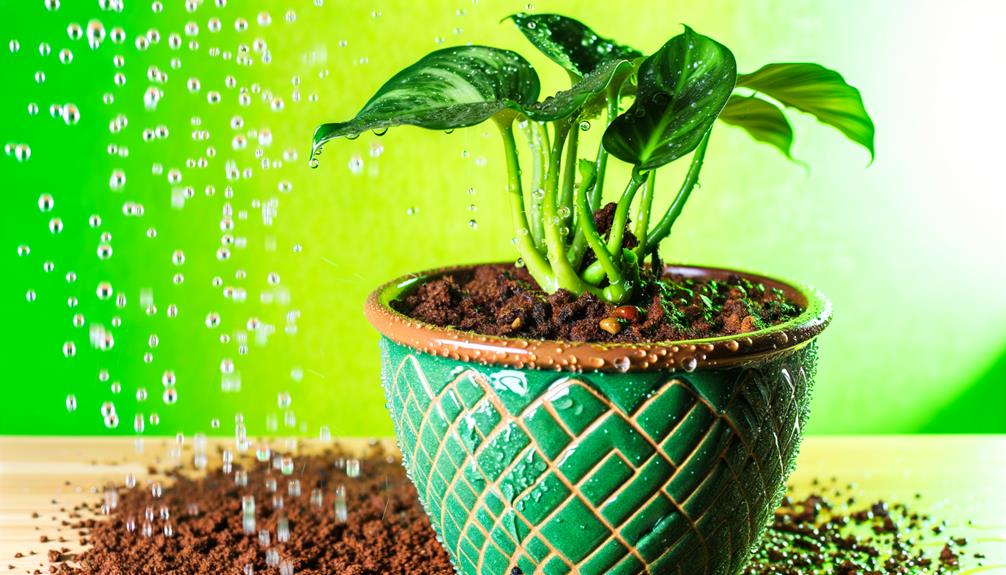What Is Philodendron Verrucosum 'Fantasy'?
Philodendron Verrucosum 'Fantasy' is a tropical plant native to the rainforests of Central and South America. It is identified by its velvety, heart-shaped leaves with intricate venation patterns and contrasting red or maroon undersides.
A hemiepiphyte, it grows both terrestrially and epiphytically, featuring bristle-covered petioles and aerial roots. Best growth occurs in bright, indirect light with high humidity and moderate watering, in well-draining soil to prevent root rot.
This species is subject to pests like spider mites and aphids and can be propagated through stem cuttings and air layering. To uncover more insights, continue exploring further.

Key Takeaways
- Philodendron Verrucosum 'Fantasy' is a tropical plant native to Central and South America's rainforests.
- It features velvety, heart-shaped leaves with intricate venation and contrasting red or maroon undersides.
- The plant thrives in high humidity, bright indirect light, and temperatures between 18°C to 24°C.
- It can grow both terrestrially and epiphytically, utilizing aerial roots for support.
- Propagation is typically done through stem cuttings or air layering for successful root development.
Origins and History

Originating from the tropical rainforests of Central and South America, Philodendron Verrucosum 'Fantasy' has a rich history deeply intertwined with the biodiversity of these regions.
This species thrives in the humid, shaded understories of rainforest ecosystems, where it plays a pivotal role in maintaining ecological balance. The plant's historical proliferation can be attributed to its adaptive morphology, enabling it to climb and spread across diverse arboreal substrates.
Botanists have long studied its symbiotic relationships with rainforest fauna and its contribution to nutrient cycling within its native habitat. Historical herbarium records and field studies underscore its significance in ethnobotany, revealing its use by indigenous communities for medicinal and ornamental purposes.
Therefore, its origins reflect a profound integration within tropical rainforest biomes.
Unique Characteristics
Philodendron Verrucosum 'Fantasy' is distinguished by its strikingly velvety, heart-shaped leaves adorned with intricate venation patterns. The leaves exhibit a vivid green hue accentuated by contrasting red or maroon undersides, enhancing their visual appeal.
The venation is pronounced, often forming a network of white or light green lines that create a dynamic visual texture. Additionally, the petioles are covered with minute, bristle-like structures, a distinctive feature contributing to its unique morphology.
This species is a hemiepiphyte, meaning it can grow both terrestrially and epiphytically. Its growth pattern involves climbing and spreading, supported by aerial roots that attach to surrounding structures.
These unique characteristics make Philodendron Verrucosum 'Fantasy' a sought-after specimen among botanical enthusiasts and collectors.
Ideal Growing Conditions

To optimize the growth of Philodendron Verrucosum 'Fantasy', it is essential to take into account its specific light and temperature requirements, alongside its water and humidity needs.
This species thrives in bright, indirect sunlight and prefers temperatures ranging between 18°C to 24°C.
Additionally, maintaining high humidity levels and ensuring consistent, moderate watering are essential for supporting its physiological functions and overall health.
Light and Temperature Needs
Achieving ideal growth for Philodendron Verrucosum 'Fantasy' involves providing medium to bright indirect light, maximizing the plant's exposure to adequate illumination without direct sunlight which may cause leaf burn. This tropical species flourishes in environments that replicate its natural habitat, where filtered light permeates the forest canopy.
Analytical studies propose maintaining ambient temperatures between 65°F and 80°F (18°C to 27°C) for peak physiological processes. Fluctuations below 60°F (15°C) can impede growth and trigger stress reactions. Temperature consistency is crucial, as extreme variations can disrupt cellular function and overall plant health.
Upholding these specific light and temperature parameters guarantees vigorous foliage development and maintains the distinct variegation feature of Philodendron Verrucosum 'Fantasy'.
Water and Humidity Requirements
Maintaining ideal conditions for Philodendron Verrucosum 'Fantasy' also requires careful attention to water and humidity parameters, as these factors greatly impact the plant's physiological health and growth dynamics. Best hydration involves ensuring soil moisture is consistently maintained without waterlogging, which can lead to root rot. Employing a well-draining substrate, such as a mix of peat, perlite, and orchid bark, can facilitate this balance.
Humidity levels should be kept within the range of 60-80%, mimicking the plant's native tropical environment. Utilizing humidifiers or pebble trays can effectively elevate ambient moisture. Regular misting can also contribute to maintaining leaf turgor and preventing desiccation. Monitoring these variables is essential for fostering robust growth and vibrant foliage in Philodendron Verrucosum 'Fantasy'.
Light Requirements
Philodendron Verrucosum 'Fantasy' thrives best in bright, indirect light, which mirrors its native understory forest conditions. This plant needs filtered sunlight to stimulate peak photosynthetic activity while preventing leaf scorch. Direct sunlight can cause leaf burn, while inadequate lighting can lead to etiolation. The ideal light spectrum includes both red and blue wavelengths, crucial for chlorophyll synthesis and overall plant vigor. Monitoring light intensity with a light meter can guarantee the plant receives suitable illumination.
| Light Type | Characteristics | Impact on Plant |
|---|---|---|
| Bright Indirect | Filtered sunlight | Optimum growth and vibrant foliage |
| Direct Sunlight | Harsh, unfiltered rays | Potential leaf burn and stress |
| Low Light | Insufficient illumination | Slow growth and elongated stems (etiolation) |
Watering Needs

Proper hydration is essential for the Philodendron Verrucosum 'Fantasy,' requiring a consistent yet carefully managed watering schedule to promote ideal physiological function and prevent root rot. This aroid species thrives in environments with high humidity and evenly moist substrate.
It is crucial to allow the top inch of soil to dry before subsequent watering to avoid waterlogging, which can worsen pathogenic fungal proliferation. Additionally, using tepid, filtered water helps reduce the risk of mineral buildup and chlorine damage. Observational cues, such as wilting or yellowing leaves, act as indicators of moisture imbalance.
Soil and Potting Mix
Selecting an appropriate soil and potting mix for Philodendron Verrucosum 'Fantasy' is important. It requires a well-draining, aerated medium rich in organic matter to support its complex root structure and prevent water retention issues. A recommended composition includes a balanced blend of peat moss, perlite, and orchid bark.
Peat moss provides moisture retention and organic nutrients, while perlite enhances aeration and drainage. Orchid bark contributes to the structure, preventing compaction and guaranteeing roots receive adequate oxygen. It is vital to avoid heavy soils that retain excess moisture, as this can lead to root rot.
Monitoring the mixture's pH level, ideally between 5.5 and 6.5, further ensures best nutrient availability and overall plant health.
Fertilization Tips

Promoting ideal growth for Philodendron Verrucosum 'Fantasy' requires a strategic fertilization regimen tailored to its specific nutrient requirements. Providing well-balanced, gradual-release fertilizers guarantees a consistent nutrient uptake, promoting vigorous growth and vibrant foliage. It is advisable to apply a diluted, water-soluble fertilizer every two months during the active growing season, typically from spring to early autumn. Over-fertilization can lead to root burn and nutrient imbalances; careful application is essential. Below is a detailed table outlining the recommended fertilization strategy:
| Fertilizer Type | Application Frequency |
|---|---|
| Well-balanced (20-20-20) | Bi-monthly |
| Gradual-release (10-10-10) | Every 3-4 months |
| Organic compost | Annually |
Following these guidelines will promote the availability of essential nutrients, nurturing the plant's health and aesthetic appeal.
Common Pests and Diseases
Philodendron Verrucosum 'Fantasy' is vulnerable to a variety of common pests and diseases, including spider mites, aphids, and fungal infections, which can affect its overall well-being and significance.
Spider mites (Tetranychidae) thrive in low moisture levels, causing speckling and webbing on leaves. Aphids (Aphididae) secrete honeydew, attracting sooty mold and hindering growth. Fungal infections, notably root rot (Pythium spp.), often result from overwatering and poor drainage, leading to wilting and leaf yellowing.
Monitoring moisture levels, ensuring sufficient air flow, and using neem oil or insecticidal soap can help reduce pest infestations. For fungal issues, using well-draining soil and proper watering practices is essential.
Early detection and intervention are key to preserving the plant's vitality and visual appeal.
Propagation Methods

The propagation of Philodendron Verrucosum 'Fantasy' can be executed through several advanced horticultural techniques.
These include the stem cutting technique and air layering process. Each method has specific procedural requirements and success rates, necessitating a detailed examination of their biological mechanisms and best environmental conditions.
Additionally, soil propagation tips will be provided to enhance root development and plant vigor during the early stages of growth.
Stem Cutting Technique
Successfully propagating Philodendron Verrucosum 'Fantasy' via stem cutting involves a meticulous understanding of the plant's vascular structure and ideal conditions for root initiation.
Begin by selecting a healthy, non-flowering stem with at least two nodes. Employ a sterilized, sharp blade to make a clean cut below a node. For best results, submerge the cut end in a rooting hormone to stimulate root growth.
Place the cutting in a well-draining growth medium, such as a mix of perlite and peat moss, ensuring the nodes are adequately covered. Maintain high humidity and consistent temperatures around 75-85°F (24-29°C).
Monitor moisture levels closely; avoid waterlogging to prevent pathogen intrusion. Root development typically initiates within 2-4 weeks under these conditions.
Air Layering Process
When considering the air layering process for propagating Philodendron Verrucosum 'Fantasy,' one must meticulously prepare the stem to promote adventitious root formation. Initially, select a healthy stem segment and make a small, upward-slanting incision to expose the cambium layer.
Carefully dust the wound with rooting hormone to boost root development. Encase the treated area with moist sphagnum moss, guaranteeing it remains consistently damp. Secure the moss with plastic wrap, creating a humid microenvironment conducive to root growth.
Periodically inspect the progress, maintaining adequate moisture levels. Once a robust root network is established, sever the stem below the new roots and transplant the air-layered segment into a suitable growing medium. This method guarantees a higher success rate in propagation.
Soil Propagation Tips
In addition to air layering, soil propagation offers an effective method for multiplying Philodendron Verrucosum 'Fantasy'. This process requires careful attention to soil composition, moisture levels, and environmental conditions.
A well-draining, aerated substrate is essential for optimal root development. This substrate should be composed of equal parts peat moss, perlite, and orchid bark.
Maintaining a consistently moist environment, without allowing waterlogging, is crucial to prevent root rot and encourage healthy growth.
Positioning the cutting in indirect, bright light is recommended to promote photosynthesis without causing leaf burn.
Ambient humidity levels of 60-70% replicate the plant's native habitat and enhance propagation success.
Regular monitoring for pests and fungal infections is necessary as they can impede root formation.
Decorating With Philodendron Verrucosum
Philodendron Verrucosum 'Fantasy,' with its striking, velvety leaves and intricate veining, offers a unique and sophisticated element for interior décor that enhances both visual interest and air quality.
The large, heart-shaped leaves, characterized by their pronounced venation and rich, deep green coloration, serve as natural focal points. This species thrives in indirect light, making it suitable for various indoor settings, from living rooms to office spaces.
When decorating, consider placing it in a location where its foliage can cascade freely, such as on a tall shelf or a plant stand. Additionally, its ability to purify air by removing volatile organic compounds (VOCs) underscores its dual functionality, contributing both aesthetic and health benefits to indoor environments.
Conclusion
Philodendron verrucosum 'Fantasy' exemplifies botanical elegance and ecological adaptability, much like a masterfully crafted symphony that harmonizes diverse elements.
This tropical marvel thrives under specific light, water, and nutrient conditions, showcasing nature's intricate balance. Its resilience against common pests and diseases underscores the robustness inherent in well-adapted species.
Propagation methods guarantee continuity, allowing enthusiasts to cultivate this botanical gem.
Ultimately, Philodendron verrucosum 'Fantasy' stands as a confirmation to the meticulous interplay between environmental factors and plant physiology.





